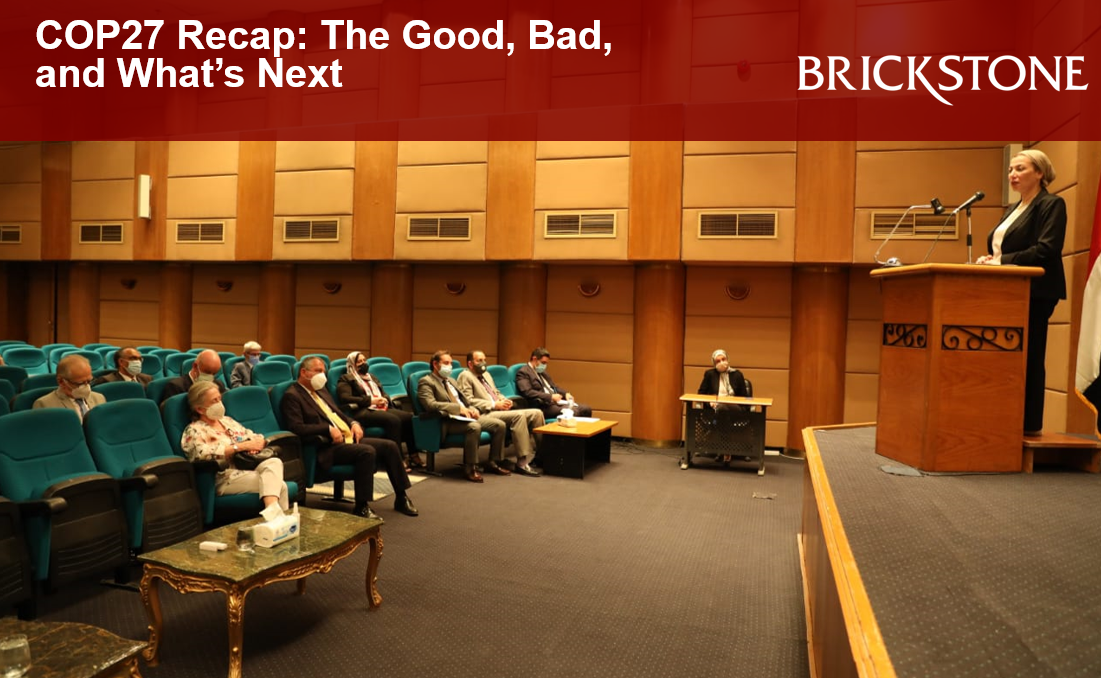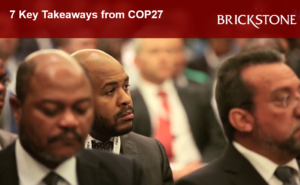COP 27 Recap: The Good, Bad, and What’s Next
According to Edie, COP 27 will have been a major event in the 2022 diary for anyone in the sustainability space.
The two-week summit began on Sunday 6 November and, while it was meant to wrap up by the end of the working day on Friday 18 November, the process over-ran significantly. The gavel finally came down on the closing agreement in the early hours of Sunday 20 November after nations finally reached agreements on sticky issues such as loss and damage and carbon markets.
This article by Brickstone reviews some institutional reports and publications on the COP 27 recap, highlighting the good, bad, and what’s next after the climate conference.
The COP 27 Recap
According to Forbes, after two weeks of tough negotiations, the climate diplomats and delegates left Sharm El Sheikh, site of COP 27. Dozens of national pavilions, temporary convention buildings, and empty hotels stood witness that the world had been there.
Yet, what has been accomplished? In the face of mounting climate perils, COP 27 featured both landmark progress and frustrating gridlock.
Set against a difficult geopolitical backdrop, COP 27 resulted in countries delivering a package of decisions that reaffirmed their commitment to limit global temperature rise to 1.5 degrees Celsius above pre-industrial levels.
Signs of Progress
In what is becoming a tradition at global climate meetings, negotiations ran into overtime. Fortunately, those extra hours produced a historic agreement on a loss and damage fund for the most climate-vulnerable nations. Compensation for loss and damage due to climate change was perhaps the thorniest issue in the Paris Agreement. For years, Western countries responsible for most historical emissions blocked discussion to avoid setting a potential precedent on financial liability. At COP27, these nations dropped their objections and assented to creating the loss and damage fund. However, questions remain on how the fund will be configured, how it will be financed, and what claims will be eligible.
COP 27 returned focus to the critical issue of climate adaptation. Less than 20% of climate financing supports adaptation and resilience efforts. According to the UN Environment Programme’s (UNEP) Adaptation Gap Report (AGR), funding for adaptation is 5-10 times below what is needed. Nations have agreed to revisit (and likely increase) the scale of adaptation finance next year.
Branded as the “implementation COP”, the summit aimed at finally fulfilling previous financial pledges for investing in renewable energy, building infrastructure to withstand extreme weather events, responding to climate disasters, and funding other such aspects of climate action.
Other bright spots on adaptation included additional funding for the UN’s Adaptation Fund, which helps communities adapt to climate change and the creation of the Sharm el-Sheikh Adaptation Agenda, focused on specific resiliency-building projects.
The final COP 27 text also included a call for the “transformation of the financial system and its structures.” Momentum is building to reform the World Bank and other development finance institutions to meet the climate challenge. One reform proposal came from Barbados’ Bridgetown Initiative, which outlined a vision of global finance that provides assistance following climate disasters, supports adaptation and mitigation efforts, and avoids crippling vulnerable countries with debt.
Another first at COP 27 was the explicit acknowledgment of the need for nature-based solutions and the right to a healthy environment. Climate change accelerates nature and biodiversity loss and exacerbates global inequalities. The inclusion of these items in the final text affirms that climate change is inextricably linked to other global challenges and climate solutions must address them too.
Too little, too late?
Ahead of COP 27 in Sharm El Sheikh, the UNEP released its annual Emissions Gap Report (EGR), showing how far the world was from our 1.5° C pathway. The assessment was a grim reminder that emissions have fully bounced back from their COVID-induced drop to near record highs. Furthermore, despite new net-zero commitments in Glasgow (COP 26), under current governmental policies, the world is still set to see carbon dioxide (CO2) emissions rise by around 10% by 2030.
By contrast, the 1.5° C trajectory necessary to limit the worst impacts of climate change requires CO2 emissions to fall by around 45-50% by 2030. With only 8 years until 2030, gaps in climate ambition and action needed to be addressed in Sharm El Sheikh.
Read more here.
Why not contact us to make your Project Happen
Our advisors and consultants would be able to schedule an online meeting with you to discuss your project with the overall objective of seeking ways to achieve the “bankability” and protection of the long term asset value of your project. Request a Meeting Now






